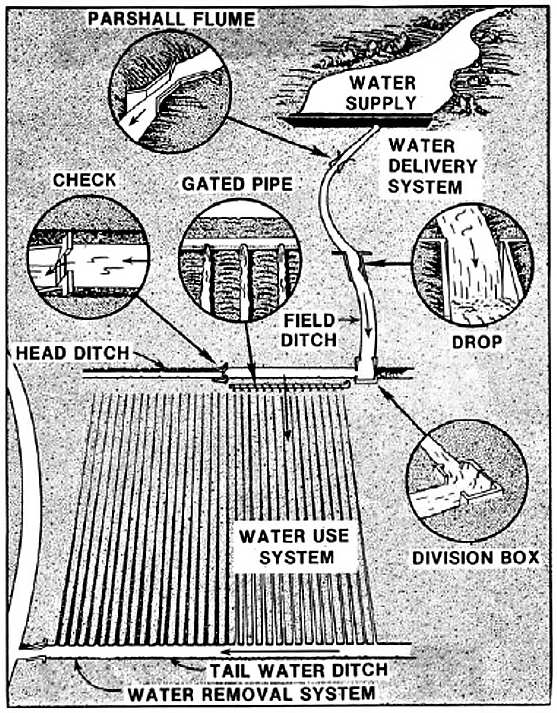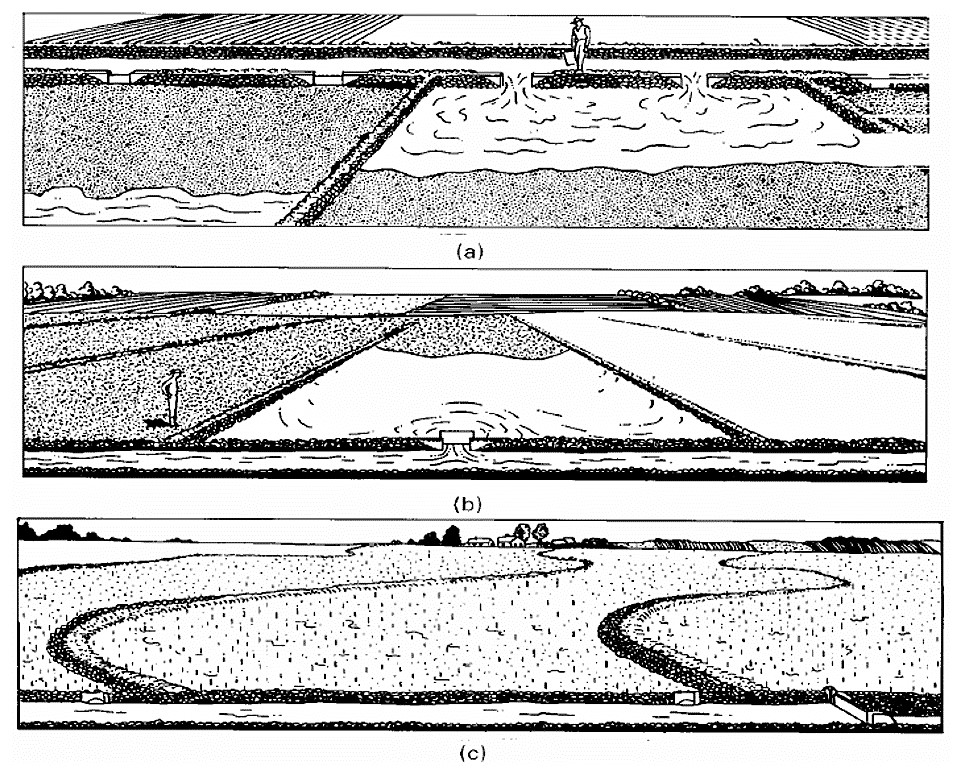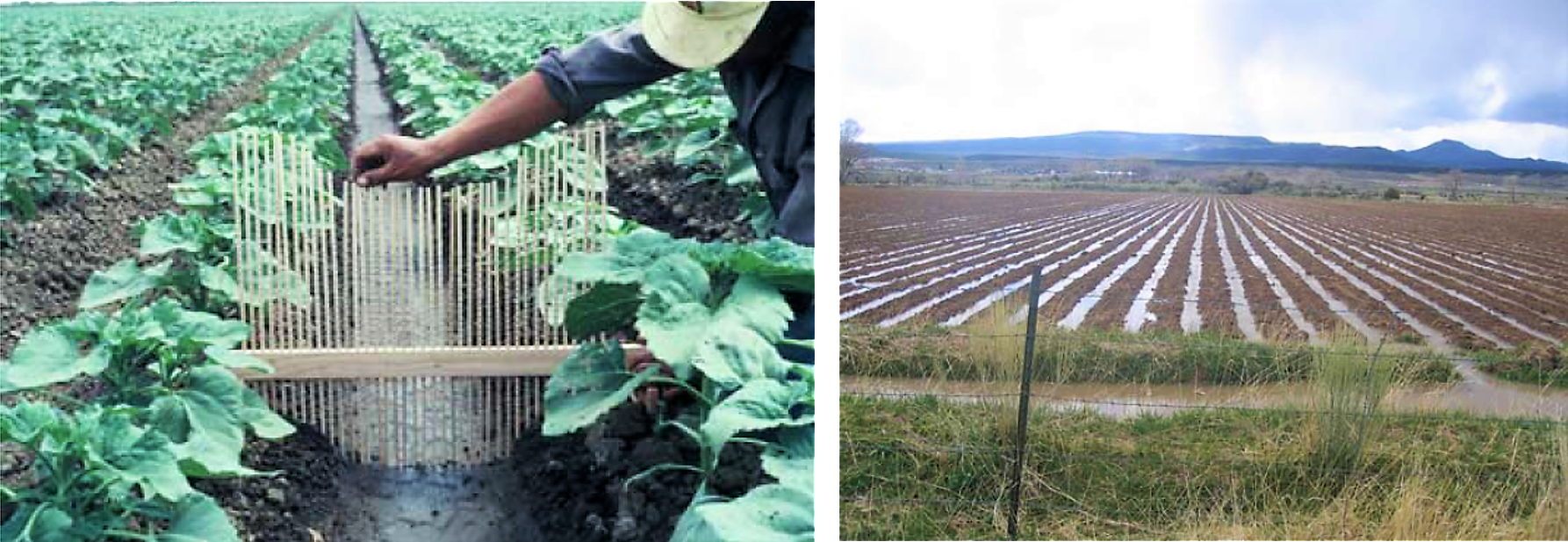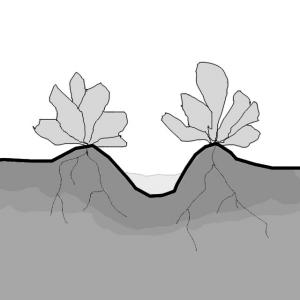Surface irrigation is mainly divided in basin, border, and furrow systems. It is widely utilised and therefore a well-known system, which can be operated without any high-tech applications. In general, it is more labour intensive than other irrigation methods. Proper design of surface irrigation systems takes into account the soil type (texture and intake rate), slope, levelness of the field, stream size, and length of run. It is generally more difficult to obtain high uniformity of water distribution in long fields on coarse textured soils (gravel and sands) than on fine textured soils (loams to clay) (HILL 2008). Levelling the fields and building the water ditches and reservoirs might be expensive, but once this is done, costs are low and the self-help capacity is very high.
| In | Out |
|---|---|
Food Products |
Surface irrigation stands for a large group of irrigation methods in which water is distributed by gravity over the surface of the field (note: surface irrigation does not include spate irrigation). The three most common methods are basin irrigation, border irrigation and furrow irrigation. Water is typically introduced at the highest point or along the edge of a field, which allows covering the field by overland flow. Historically, surface irrigation has been the most common method of irrigating agricultural land. The defining feature of surface irrigation methods is that the soil is used as the transport medium (as opposed to pipelines (see subsurface irrigation, drip irrigation or through the air, as with sprinklers).
Surface irrigation methods contain two basic categories: ponding (surface water pooled in a puddle) and moving water. The moving water methods require some runoff or ponding to guarantee adequate infiltration at the lower end of the field. The soil type controls the length of the run and the depth of infiltrated over time. The better the quality of the soil is the less is the unnecessary runoff and the better the infiltration into the soil and therefore the use for the crops (BURT 2000). Due to ponding however, it is important not to irrigate the crops during the day but in the early morning or at night in order to avoid water loss due to evaporation.
Each surface system has its own unique advantages and disadvantages depending on such factors as initial development costs, size and shape of individual fields, soil characteristics, nature and availability of the water supply, climate, cropping pattern, social preferences and structures, and historical experience (WALKER 2003).

Basin Irrigation
Basin irrigation is the most common form of surface irrigation, particularly in regions with layouts of small fields. If a field is level in all directions, is encompassed by a dyke to prevent runoff, and provides an undirected flow of water onto the field, it is herein called a basin.
If the basins are small or if the discharge rate available is relatively large, there are few soils not amenable to basin irrigation. Generally, basin irrigation is favoured by moderate to slow intake soils and deep-rooted, closely spaced crops. Crops, which do not tolerate flooding and soils subject to crusting can be basin irrigated by furrowing or using raised bed planting. Basin irrigation is an effective method of leaching salts from the soil profile into the deeper groundwater.

Basin irrigation systems can be automated with relatively simple and inexpensive flow controls at the basin inlet. However, basin irrigation has a number of limitations in association with agriculture in the less developed countries: Accurate land levelling is prerequisite to high uniformities and efficiencies, but this is difficult to accomplish in small areas;the perimeter dikes must be well maintained to eliminate breaching and waste; and it is difficult and often infeasible to incorporate the use of modem farm machinery in small basins, thereby limiting small-scale basin irrigation to hand and animal powered cultivation (WALKER 2003).
Border Irrigation System
In many circumstances, border irrigation can be viewed as an expansion of basin irrigation to include long rectangular or contoured field shapes, longitudinal but no lateral slope, and free draining or blocked conditions at the lower end.

In border irrigation, a field is divided into strips separated by border ridges running down the slope of the field. The width of the stripes is usually from 20 to 100 feet (6 to 30 metres). The area between the ridges is flooded during irrigation. Border irrigation is used for tree crops and for crops as alfalfa (Medicago sativa) and small grains (UCCE 2003).

Furrow Irrigation
An alternative to flooding the entire field surface is to construct small channels along the primary direction of water movement. Water introduced in these furrows infiltrates through the wetted perimeter and moves vertically and laterally thereafter to refill the soil. Furrows can be used in conjunction with basins and borders to overcome topographical variation and crusting (WALKER 2003). Furrows are well adapted to row crops and orchards or vineyards (BURT 2000).

Furrow systems require more labour than border or basin systems. Some disadvantages are salinity hazards between the furrows, limited machinery mobility across the lateral field direction and an increased erosion potential. On the other hand, topographical conditions can be more severe and variable, and the smaller wetted area can reduce evaporation loss (WALKER 2003).
The three most important hardware items for an efficient furrow irrigation are (BURT 2000):
- A tailwater return flow system, which incorporates a reservoir
- Short furrows for an acceptable advanced ratio
- A large variable water supply stream
There is one disadvantage of surface irrigation that confronts every designer and irrigator. The soil, which must be used to convey the water over the field, has properties that are highly varied both spatially and temporally. They become almost indefinable except immediately preceding the watering or during it. This creates an engineering problem in which at least two of the primary design variables, discharge and time of application, must be estimated not only at the field layout stage but also judged by the irrigator prior to the initiation of every surface irrigation event. Thus, while it is possible for the new generation of surface irrigation methods to be attractive alternatives to sprinkler and trickle systems, their associated design and management practices are much more difficult to define and implement (WALKER 1989).
Levelling the fields and building the water ditches and reservoirs might be expensive, but once this is done, costs are low and the self-help capacity is very high. Thus, the expected life of the system, fixed costs, and annual operation costs (energy, water depreciation, land preparation, maintenance, labour, taxes, etc.) should be included in the analysis when selecting an irrigation system (WALKER 2003). The water allocation is done by gravity, therefore no energy is required. On the other hand, a surface irrigation system is labour intensive, which should be considered.
Good operation of any irrigation system includes matching the irrigation duration with the rate of application and the intake rate of the soil to maximise the fraction of water stored in the root zone. Operation of surface irrigation requires being there to “tend” the water, i.e. to move the water to successive application points as it reaches the end of the run. (HILL et al. 2008).
Ditches should be cleaned out at least annually and more often if needed. A shovel can be used to clean smaller ditches. A mechanical ditcher and tractor is very helpful on larger ditches. Often ditch cleaning is an early spring “rite” to be completed prior to the first delivery of water. Many irrigation and canal companies require that shareholders maintain their own head gates and keep them in good operating condition. In areas where rodent damage is a problem, “tromping gopher holes” or otherwise fixing leaks in ditches may be a daily chore. Periodic re-levelling of surface irrigated fields may be needed to compensate for soil settlement or consolidation over time (HILL et al. 2008).
| Working Principle | There are three main surface irrigation systems: Basin (flooded field), border (the field is divided into stripes) and furrow (small channels along the primary direction of water movement). The water is distributed by gravity over the surface of the field |
| Capacity/Adequacy | As long as the field can be levelled it can be implemented. |
| Performance | It is an old approved system and therefore it has a high performance |
| Costs | If topography is uneven, capital costs are high. Furthermore, it is a labour intensive system, which could raise the costs. |
| Self-help Compatibility | High |
| O&M | Ditches should be cleaned out periodically; leaks have to be fixed as fast as possible. |
| Reliability | If it is well maintained and the ditches are clean it is very reliable. |
| Main strength | It is widely utilised and users have at least a minimal understanding of how to operate and maintain. Furthermore, the water is distributed by gravity. |
| Main weakness | The soil, which must be used to convey the water over the field, has properties that are highly varied both spatially and temporally. They become almost indefinable except immediately preceding the watering or during it what makes design kind of difficult |
This system depends on three factors: type of soil, water quality and climate, plant and labours. If the soil is very permeable, it is difficult to transport the water over the surface and may not the entire field will be irrigated. But surface irrigation is not negatively influenced by winds or sediments and debris as are sprinkler systems.
Moreover, salinity is less of a problem under surface irrigation because of less risk of clogging pipes and salts can be leached from the soil profile. Surface irrigation is not a high-automated system, what makes it more simple, but it requires therefore also more labours.
Water for Irrigation
Infonet-biovision.org is a web-based information platform offering trainers, extension workers and farmers in East Africa a quick access to up-to-date and locally relevant information in order to optimise their livelihoods in a safe, effective, sustainable and ecologically sound way.
INFONET-BIOVISION (2010): Water for Irrigation. Zürich: Biovision URL [Accessed: 09.04.2019]Small Acreage Irrigation System Operation and Maintenance
This manual describes the operation and maintenance of the three most common irrigation systems “surface irrigation”, “sprinkler irrigation” and “low flow irrigation” (micro or drip).
HILL, R.W. PATTERSON, R. BARNHILL, J.V. (2008): Small Acreage Irrigation System Operation and Maintenance. Logan: Utah State University URL [Accessed: 20.06.2011]Ground Water Protection Area. Irrigation Systems and their Performance
This short article describes the irrigation systems “surface irrigation”, “sprinkler irrigation” and “micro irrigation” and its performance.
UCCE (2005): Ground Water Protection Area. Irrigation Systems and their Performance. California: University of California Cooperative Extension (UCCE). [Accessed: 20.06.2011].Guidelines for Designing and Evaluating Surface Irrigation Systems
SIRMOD III - Surface Irrigation Simulation Evaluation and Design
This is a very detailed document about surface irrigation simulation, evaluation and design. The aim of the manuscript is to improve the water irrigation management, which is an important step to guarantee security and stability in food supplies. You will be able to find the PDF presentation downloading the ZIP archive and opening the Surface Irrigation Design file.
WALKER, W.R. (2003): SIRMOD III - Surface Irrigation Simulation Evaluation and Design. Guide and Technical Documentation. "PDF Presentation". Logan, Utah (USA): Utah State University (USU). URL [Accessed: 07.05.2019]Irrigation, Food Security and Poverty – Lessons from three large Dams in West Africa
This report summarises the results of four years of research on three existing dam and rice field sites: Sélingué in Mali, Bagré in Burkina Faso and Anambé in Senegal. The aim of these micro and macro-economic studies was to analyse the financial and economic viability of water infrastructure projects and opportunities for improving the living conditions of smallholder farmers after the construction of dams.
BAZIN, F. et al. (2017): Irrigation, Food Security and Poverty – Lessons from three large Dams in West Africa. Global Water Initiative (GWI) URL [Accessed: 07.05.2019] PDFFood security and productive sanitation systems
The factsheet describes the food security situation especially in light of limited global resources, the role of sustainable sanitation in closing the nutrient loop and increasing productivity, and challenges in implementing productive sanitation systems.
SUSANA (2009): Food security and productive sanitation systems. (= SuSanA fact sheet 05/2009 ). Eschborn: Sustainable Sanitation Alliance (SuSanA) URL [Accessed: 07.05.2019]Small Acreage Irrigation System Selection
How can you decide what irrigation system you need? This paper answers some of the most important “system selection questions”.
BARNHILL, J.V. HILL, R.W. PATTERSON, R. (2009): Small Acreage Irrigation System Selection. Logan: Utah State University URL [Accessed: 20.06.2011]Selection of irrigation methods for agriculture. Environmental and Water Research Institute
This report provides an overview of various agricultural irrigation methods. The variations of each general method (surface irrigation, drip/micro irrigation, sprinkler irrigation, and sub-irrigation) are described. The capabilities, limitations, institutional considerations, and economic factors of the methods and their variations are explained. These explanations will facilitate the proper selection of irrigation method for respective circumstances, depending upon crop, climate, economics, water quality, support infrastructure, energy availability, and numerous other factors.
BURT, C. M. (2000): Selection of irrigation methods for agriculture. Environmental and Water Research Institute. Virginia: ASCE Publications URL [Accessed: 29.07.2010]Irrigation Water Management: Irrigation Methods
This report — the full version only available on-line — shortly explains various irrigation techniques and contains pictures of all the different methods.
FAO (1988): Irrigation Water Management: Irrigation Methods. (= Training manuals - 5 ). Rome: Food and Agriculture Organization of the United Nations (FAO) URL [Accessed: 12.07.2010]Small Acreage Irrigation System Operation and Maintenance
This manual describes the operation and maintenance of the three most common irrigation systems “surface irrigation”, “sprinkler irrigation” and “low flow irrigation” (micro or drip).
HILL, R.W. PATTERSON, R. BARNHILL, J.V. (2008): Small Acreage Irrigation System Operation and Maintenance. Logan: Utah State University URL [Accessed: 20.06.2011]Ground Water Protection Area. Irrigation Systems and their Performance
This short article describes the irrigation systems “surface irrigation”, “sprinkler irrigation” and “micro irrigation” and its performance.
UCCE (2005): Ground Water Protection Area. Irrigation Systems and their Performance. California: University of California Cooperative Extension (UCCE). [Accessed: 20.06.2011].SIRMOD III - Surface Irrigation Simulation Evaluation and Design
This is a very detailed document about surface irrigation simulation, evaluation and design. The aim of the manuscript is to improve the water irrigation management, which is an important step to guarantee security and stability in food supplies. You will be able to find the PDF presentation downloading the ZIP archive and opening the Surface Irrigation Design file.
WALKER, W.R. (2003): SIRMOD III - Surface Irrigation Simulation Evaluation and Design. Guide and Technical Documentation. "PDF Presentation". Logan, Utah (USA): Utah State University (USU). URL [Accessed: 07.05.2019]Irrigation Practice and Policy in the Lowlands of the Horn of Africa
The drought of 2011 and the famine that followed in politically instable Somalia highlighted the vulnerability of the lowlands of the Horn of Africa. It is a story revisited with high frequency – 2000, 2005, and 2008. Climate variability is easily mentioned as the main attributing factor. Clearly it is – but there is also extensive land use change, because of the widespread invasion of invasive species (prosopis in particular) and the decimation of natural wood stands for charcoal production (particularly in Somalia). 2011 was a crisis year – but even in a normal years food insecurity is common. In the Afar lowlands in Ethiopia food aid has become part of the livelihoods, with most of the people dependent on it – including reportedly middle class families. There is a growing realization that water resource development – appropriate to the context – has to have a place in addressing food insecurity in the Horn of Africa. This paper focuses on irrigation policy and practice in the arid lowlands of the Horn that have been hit hardest and most frequent in the drought episodes
ALEMEHAYU, T. DEMISSIE, A. LANGAN, S. EVERS, J. (2011): Irrigation Practice and Policy in the Lowlands of the Horn of Africa. Rome: Food and Agriculture Organization of the United Nations (FAO) URL [Accessed: 26.03.2012]Phosphorus Loss with Surface Irrigation
There are two main mechanisms in a surface irrigation system which influence phosphorous (P) transport; erosion and desorption of P into irrigation runoff water. This report describes reduction strategies to keep phosphorous in the soil.
BJORNBERG, D. LEYTEM, A. (n.y): Phosphorus Loss with Surface Irrigation. Kimberley: United States Department of Agriculture – Agricultural Research Service (USDA-ARS) URL [Accessed: 07.05.2019]Effect of Basin, Furrow and Raingun Sprinkler Irrigation Systems on Irrigation Efficiencies, Nitrate-Nitrogen Leaching and Yield of Sunflower
A field study was conducted on sunflower by using different irrigation techniques, such as basin, furrow and raingun sprinkler systems at Post-Graduate Agricultural Research Station (PARS), University of Agriculture, Faisalabad during 1998-2002. The comparison of irrigation efficiencies, nitrate leaching and the yield of sunflower was noted.
RANA, M.A. ARSHAD, M. MASUD, J. (2006): Effect of Basin, Furrow and Raingun Sprinkler Irrigation Systems on Irrigation Efficiencies, Nitrate-Nitrogen Leaching and Yield of Sunflower. Islamabad: Pakistan Journal of Water Resources URL [Accessed: 07.05.2019]Demonstration of Surface Irrigation Evaluation Technology in the Gouldburn Murray Irrigation District
In the present study, field trials were conducted using the IrriMATETM system at a limited number of sites with the objective to demonstrate the application of surface irrigation evaluation to bay irrigated pasture and to indentify the potential gains in irrigation performance. Although the sample of sites was small they provide an indication of the level of performance across the Goulburn Murray Irrigation District (GMID) and the opportunity for substantial water savings through changed practice on-farm.
SMITH, R. GILLIES, M. SHANAHAN, M. CAMPBELL, B. WILLIAMSON, B. (2010): Demonstration of Surface Irrigation Evaluation Technology in the Gouldburn Murray Irrigation District. Part I: Evaluating the Performance of Bay Irrigation. (= Technical Report ). Queensland: Cooperative Research Centre (CRC) for Irrigation Future. [Accessed: 20.06.2011] PDFWater for irrigation
Water for irrigation: different irrigation techniques and tips for using water for irrigation
Guidelines for designing and evaluating surface irrigation systems
The online version of the book “Guidelines for Designing and Evaluating Surface Irrigation Systems” written by W.R. Walker in 1989 is still a very precious open source which contains all important information about surface irrigation.
Traditional diversion-based phad irrigation systems help mitigate risk of crop failure in the drought-prone farmer suicide belt of Vidarbha, Maharashtra
This videos show how traditional diversion-based phad irrigation systems are being revived and promoted in Vidarbha, Maharashtra. Phads are a community-based and managed diversion irrigation management system.



